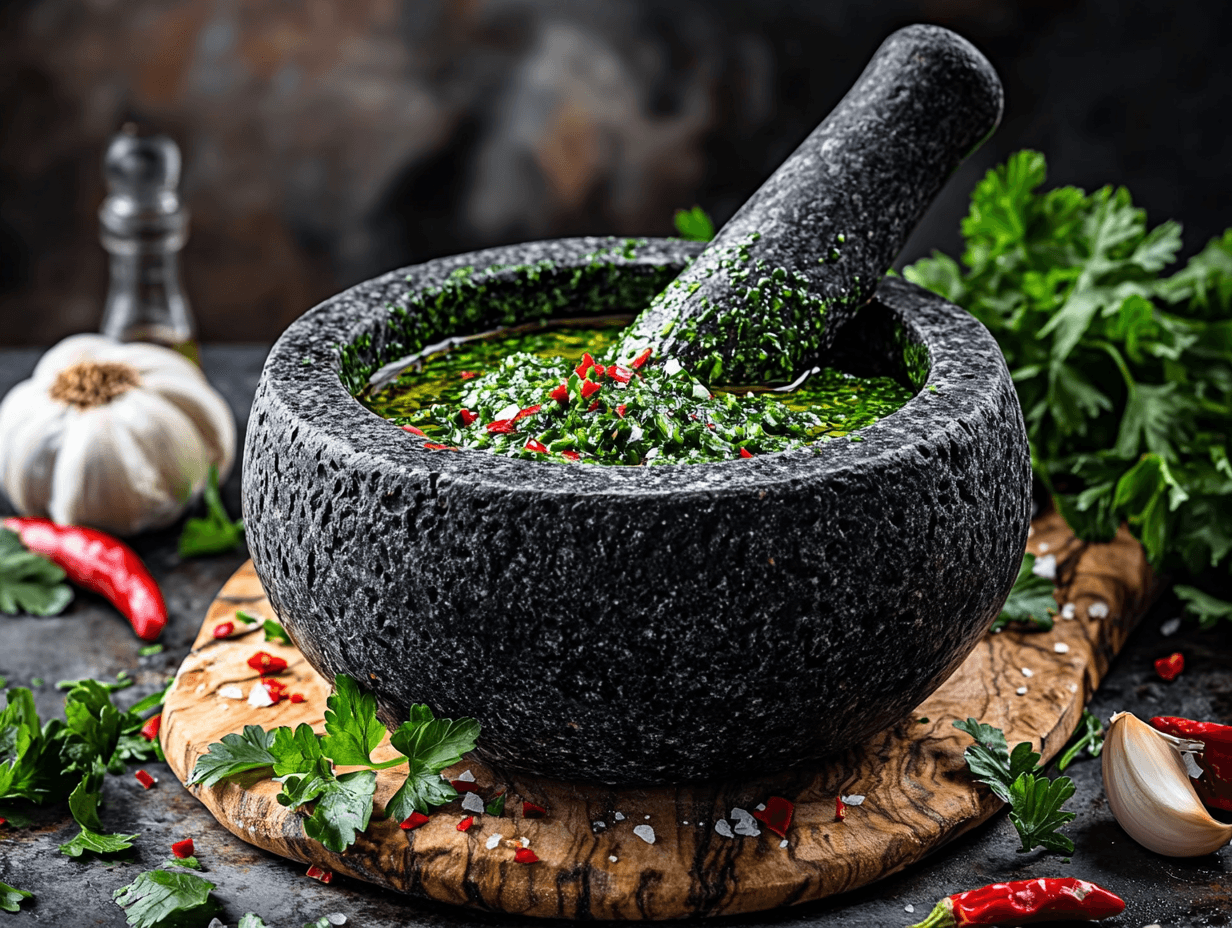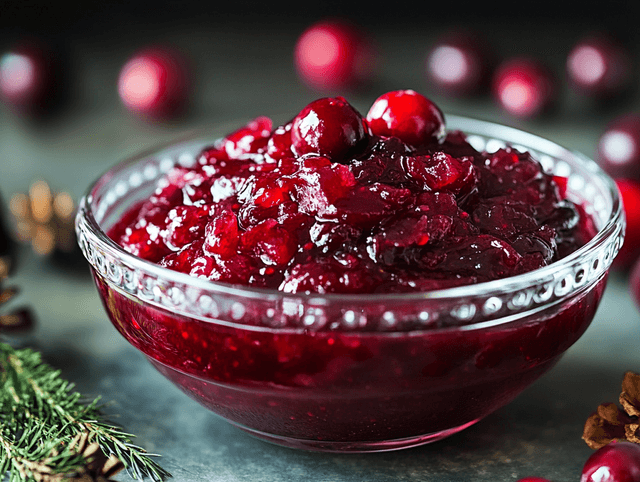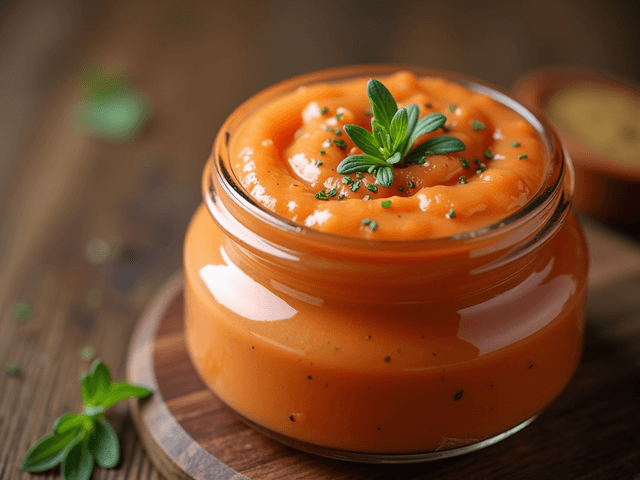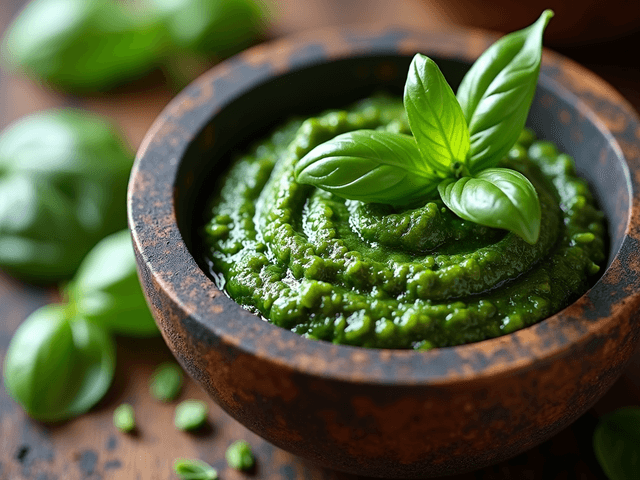What is Chimichurri?
Chimichurri is a traditional sauce from Argentina and Uruguay that has become an iconic element of South American cuisine. It's characterized by its fresh and aromatic profile, made primarily with chopped herbs, spices, and basic ingredients like garlic, vinegar, oil, and salt.
This versatile sauce serves multiple purposes in the kitchen: it's mainly used as a condiment to enhance the flavor of grilled meats, but it can also be used as a marinade, salad dressing, or seasoning for other dishes.
Chimichurri comes in two main varieties:
- Green chimichurri: The classic and most common version, made with parsley as the main herb
- Red chimichurri: A variation that includes ground chili or red pepper, giving it a characteristic spicy touch
This sauce has crossed borders and is now internationally recognized as an essential accompaniment to Argentine grilled meats, significantly contributing to its worldwide fame.

Herb Cutting Techniques: Food Processor vs Hand Cutting
Herbs for chimichurri can be cut in two main ways, each with its own characteristics and results:
Hand Cutting
The traditional hand-cutting method offers greater control and precision. To do it correctly:
- The chiffonade cut is recommended for herbs, rolling the leaves and cutting them into very thin, elongated strips.
- It's important to keep the knife well-sharpened to prevent bruising the herbs.
- The "bear claw" technique with the free hand helps maintain safety during cutting.
Food Processor
The food processor offers speed and efficiency, making it ideal for large quantities. Its features include:
- Allows for uniform chopping, mixing, and emulsifying of ingredients.
- Has different speeds to control the cutting size.
- It's faster but may result in less uniform chopping than manual cutting.
Important Considerations
For hand cutting:
- Hand cutting allows for uniform pieces of the exact desired size, resulting in a more professional and attractive presentation.
- When cutting manually, herbs release their essential oils in a more controlled manner, resulting in a more intense and aromatic flavor.
- This technique requires practice and patience to develop the necessary skill, but offers better results in terms of final quality.
For the food processor:
- The food processor significantly reduces preparation time, allowing you to make large quantities of chimichurri in minutes.
- It's especially useful when preparing chimichurri for large events or restaurants, optimizing production time.
- Special care must be taken with processing time, as over-processing can turn herbs into a puree and alter the final texture.
The choice between both methods will depend on the quantity to prepare, available time, and desired final result.

The Role of Olive Oil in Chimichurri and How to Choose the Best
Olive oil plays a fundamental role in chimichurri, acting as the base and unifying element of all flavors. Its function is multiple:
Main Functions
- Acts as an emulsifier, allowing a stable and consistent mixture between liquid and dry ingredients.
- Helps extract and preserve the essential oils from the herbs.
- Provides texture and body to the sauce.
Recommended Types of Oil
Extra Virgin Olive Oil:
- It's the premium choice for chimichurri as it's the first pressed juice from unrefined olives.
- Provides a distinctive fruity and aromatic flavor.
- Has a color ranging from light yellow to bright greenish-gold.
Virgin Olive Oil:
- Is an acceptable alternative that maintains nutritional properties.
- Has a slightly more bitter taste due to the presence of polyphenols.
Usage Tips
- For traditional chimichurri, use good quality olive oil that adds flavor.
- The ideal proportion is 1/2 cup of oil per basic recipe.
- It's important to add the oil in a thin stream while mixing the other ingredients to achieve better emulsion.
The success of a good chimichurri will largely depend on the quality of the olive oil used, as this ingredient is essential for integrating and enhancing all the flavors in the preparation.

Essential Ingredients for Authentic Chimichurri
Traditional Argentine chimichurri is distinguished by its simplicity and perfect balance between ingredients. The key is using fresh herbs and good quality olive oil.
- Fresh Parsley: 2 tightly packed cups - Provides the characteristic flavor and bright green color.
- Dried Oregano: 2 tablespoons - Gives the traditional Argentine aromatic touch.
- Fresh Garlic: 3-4 cloves - Provides intensity and natural heat.
- Olive Oil: 1/2 cup - Base that integrates all flavors and textures.
- Red Wine Vinegar: 2 tablespoons - Adds acidity and helps preserve the herbs.
- Red Pepper Flakes: 1 tablespoon - Choose according to taste to provide the characteristic spicy touch.
- Coarse Salt: 1 tablespoon - Enhances all flavors.
- Black Pepper: 1 teaspoon - Adds depth and character.
- Water: 2 tablespoons - Helps balance acidity and smooths the mixture.

How to Make Chimichurri Step by Step
Making authentic chimichurri requires attention to detail and the correct order of ingredient incorporation. Following these steps, you'll achieve a perfectly balanced and flavorful sauce.
Step 1: Herb Preparation
- Wash and completely dry 2 cups of fresh parsley, removing any excess moisture to prevent oxidation.
- If choosing to cut by hand, use the chiffonade technique by rolling the leaves and cutting them into thin, uniform strips.
Step 2: Garlic Preparation
- Peel and finely chop 3-4 cloves of fresh garlic until you have very small, uniform pieces.
- If using a food processor, place the garlic first to ensure uniform chopping before adding the herbs.
Step 3: Dry Spice Mixture
- Combine 2 tablespoons of dried oregano with 1 tablespoon of red pepper flakes.
- Add 1 tablespoon of coarse salt and 1 teaspoon of black pepper, mixing evenly.
Step 4: Liquid Incorporation
- Pour 1/2 cup of extra virgin olive oil in a thin stream to achieve better emulsion.
- Add 2 tablespoons of red wine vinegar and 2 tablespoons of water, mixing gently.
Step 5: Resting and Adjustment
- Let the mixture rest for at least 30 minutes at room temperature.
- Taste and adjust flavors as needed, especially salt and spiciness.
The chimichurri improves its flavor over time, allowing ingredients to perfectly integrate. You can store it in an airtight container in the refrigerator for up to a week, although its most intense flavors are appreciated in the first 24-48 hours.

Tips to Prevent Herb Oxidation
To keep chimichurri fresh and maintain its characteristic bright green color, it's essential to follow these practical tips:
Before Preparation:
- Completely dry the herbs after washing them with a clean towel to avoid excess moisture.
- Use a sharp knife when cutting to prevent the herbs from bruising.
- Process herbs briefly if using a food processor to prevent them from releasing excess moisture.
During Preparation:
- Add olive oil in a thin stream while mixing ingredients to achieve better emulsion.
- Don't overprocess the mixture to prevent the olive oil from oxidizing and becoming bitter.
- Maintain a proper proportion of vinegar and oil to naturally preserve the herbs.
For Storage:
- Transfer to a glass container with an airtight lid.
- Add a thin layer of olive oil on the surface before closing the jar.
- Keep in an airtight container in the refrigerator.
- Always use clean utensils and avoid cross-contamination when serving.

Resting Time: Why It's Important to Let Chimichurri Rest
The resting time is a crucial stage in chimichurri preparation that allows it to develop its full flavor potential. This process has several important benefits:
Minimum Resting Time
- A minimum rest of 2 hours is recommended for the flavors to begin integrating properly.
- For optimal results, it's best to let it rest between overnight and a full day.
Benefits of Resting
- Allows the essential oils from the herbs to release completely.
- Helps dry ingredients hydrate and release their aromas and flavors.
- Enables flavors to intensify and blend uniformly.
Important Considerations
- Chimichurri can be consumed immediately after preparation, but it won't develop its full flavor potential.
- The best results are obtained when preparation is planned in advance.
- During resting, keep chimichurri at room temperature if using the same day, or refrigerated if storing for longer.
The resting period is essential for achieving an authentic and flavorful chimichurri, allowing all ingredients to reach their maximum flavor expression.

Uses of Chimichurri in the Kitchen
Chimichurri is a versatile sauce that can be used in multiple ways in the kitchen:
As a Marinade:
- To tenderize and flavor meats before cooking, especially tough cuts that need tenderizing.
- In the preparation of fish and poultry, adding flavor and moisture to white meats.
- To marinate vegetables before roasting, enhancing their natural flavors.
- Perfect for meats going to the grill or barbecue, creating an aromatic crust while cooking.
As a Condiment:
- To enhance the flavor of prepared dishes, adding a fresh and herbaceous touch.
- In the preparation of pizzas and empanadas, as an ingredient that adds distinctive flavor.
- To flavor oven-baked vegetables, mixing it before cooking.
- As a base for other sauces by mixing it with mayonnaise or creams.
As a Dressing:
- To enhance fresh salads, adding an Argentine touch to vegetables.
- In sandwiches and wraps, as a flavorful alternative to traditional sauces.
- To flavor pasta dishes, creating a Latin version of Italian cuisine.
- As a complement to potato dishes, adding a spicy and aromatic touch.
As an Accompaniment:
- Main sauce for roasted and grilled meats, especially for red meat cuts.
- Perfect complement for choripanes and empanadas, adding freshness and flavor.
- Accompaniment for grilled fish and seafood, providing an herbaceous contrast.
- Sauce for roasted or steamed vegetables, enhancing their natural flavors.
The versatility of chimichurri allows it to adapt to different dishes, adding a characteristic and aromatic touch of flavor to any preparation.

How to Store Chimichurri and How Long It Lasts
Proper storage of chimichurri is essential to maintain its freshness and characteristic flavor. Good storage can significantly extend its shelf life and preserve its organoleptic properties.
Jar Preparation:
- Sterilize the glass jar by submerging it in boiling water for 10 minutes and let it dry completely before using.
- Add a thin layer of extra virgin olive oil on the surface before closing to create a protective seal.
- Label the jar with the preparation date and keep the container clean and dry at all times.
For Refrigeration:
- Keep in the coldest part of the refrigerator, ideally between 2-4°C to better preserve fresh ingredients.
- Make sure to close the jar tightly after each use to maintain freshness.
For Freezing:
- Divide the chimichurri into small portions using ice cube trays for better portion control.
- Transfer the frozen cubes to an airtight bag, removing as much air as possible before sealing.
Duration According to Storage Method:
- Homemade refrigerated and sealed chimichurri: 2-3 weeks.
- Homemade refrigerated and opened chimichurri: 1 week.
Important Tips:
- Avoid exposing chimichurri to sudden temperature changes that can affect its preservation and flavor.
- Keep chimichurri away from direct light and heat, even when in the refrigerator.
- Prepare amounts that can be consumed within a reasonable period to maintain maximum freshness.
- Watch for changes in color, smell, or texture that may indicate spoilage and discard if there are signs of alteration.

Frequently Asked Questions (FAQs)
Q: Why does my chimichurri taste bitter?
A: The bitter taste can appear from using too much parsley or old parsley. To balance it, you can add more vinegar and lemon juice, and if needed, a touch of extra virgin olive oil.
Q: What's the difference between pesto and chimichurri?
A: Chimichurri doesn't contain nuts or cheese, while pesto is made with herbs, nuts, and cheese, having a creamier texture. Chimichurri includes vinegar for acidity and is mainly used as a sauce for meats.
Q: Can I use a food processor to make chimichurri?
A: While it's possible to use a processor, the traditional hand-cutting method better preserves the herbs' essential oils and allows better texture control. If using a processor, do it with short pulses to avoid over-processing.
Q: Can chimichurri be made without chili peppers?
A: Chimichurri can be prepared without spicy ingredients if you prefer. Simply omit the ground chili or red pepper flakes and adjust the amount of black pepper to your taste.











